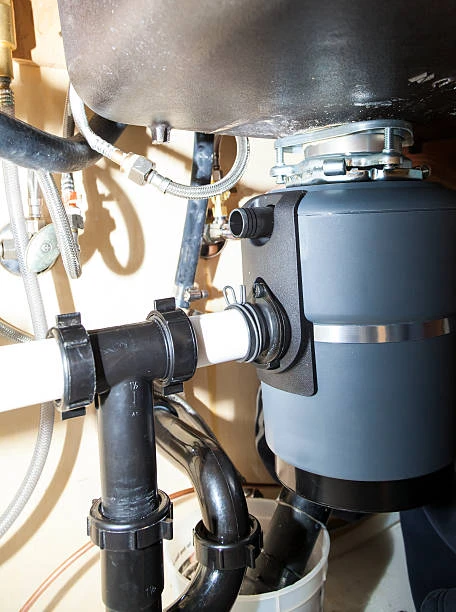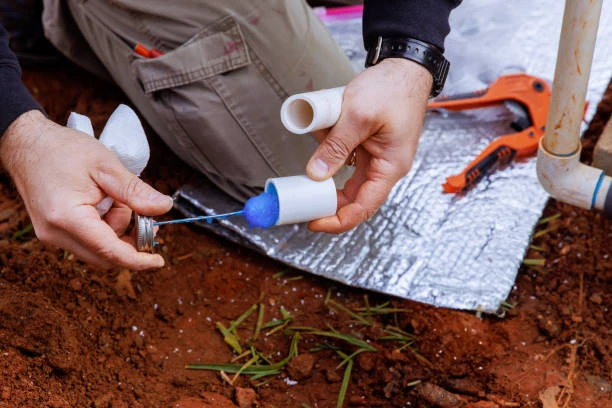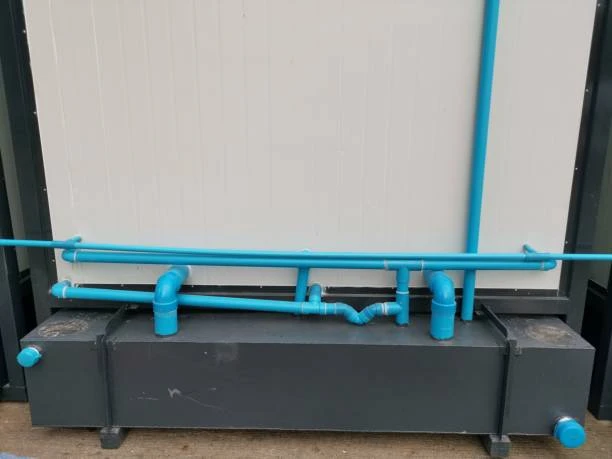The demand for efficient and sustainable piping solutions in Europe has led to the introduction of new standards for PVC-O pipes. These pipes, known for their high performance and reduced environmental impact, are gaining popularity in various applications, from water distribution to irrigation systems. As the industry evolves, the focus is not only on the materials used but also on the connections and fittings that ensure the integrity of the entire system. This article explores the new European standard for PVC-O pipes, the advantages of PEX fittings, and their growing significance in modern infrastructure.
Understanding PVC-O Pipes
PVC-O, or oriented polyvinyl chloride, pipes are a type of thermoplastic pipe that has been engineered to offer superior mechanical properties compared to traditional pipes. The orientation process enhances the molecular structure of the PVC, resulting in increased strength, flexibility, and resistance to impact. As a result, PVC-O pipes are ideal for various applications, including:
- Water supply systems
- Irrigation networks
- Wastewater management
- Industrial applications
The new European standard for PVC-O pipes aims to ensure that these products meet specific quality and performance criteria, providing manufacturers and consumers with guidelines for safe and efficient use.
Key Features of PVC-O Pipes
The introduction of the new European standard for PVC-O pipes brings several key features that set them apart from traditional pipes:
- Higher Pressure Resistance: PVC-O pipes can withstand higher internal pressures, making them suitable for water supply systems where pressure fluctuations are common.
- Lighter Weight: These pipes are lighter than their traditional counterparts, facilitating easier handling and installation. This is particularly beneficial for large-scale projects where transportation and labor costs are significant.
- Enhanced Flexibility: The orientation process gives PVC-O pipes increased flexibility, allowing them to bend without breaking. This flexibility is crucial in areas with challenging terrains or seismic activity.
- Reduced Environmental Impact: PVC-O pipes are produced using less material and energy compared to traditional PVC, leading to a lower carbon footprint. Additionally, their durability means they have a longer lifespan, reducing the need for frequent replacements.
- Recyclability: Like other products, PVC-O pipes are recyclable, contributing to a circular economy and reducing waste.
The Importance of PEX Fittings
As PVC-O pipes gain traction in the market, the role of fittings becomes increasingly important. PEX (cross-linked polyethylene) fittings are rapidly becoming the preferred choice for connecting pipes in various applications. Here’s why PEX fittings complement the advantages of PVC-O pipes:

1. Flexibility and Ease of Installation
PEX fittings are known for their flexibility, allowing for easier installation in tight spaces or complex layouts. This characteristic is particularly advantageous in conjunction with PVC-O pipes, which also offer flexibility. Together, they enable quicker and more efficient installations, reducing labor costs.
2. Corrosion and Scale Resistance
One of the primary advantages of PEX fittings is their resistance to corrosion and scale build-up. Unlike metal fittings that can corrode over time, PEX fittings maintain their integrity, ensuring a longer lifespan for the entire piping system. This property is especially beneficial in water supply and irrigation systems, where water quality is paramount.
3. Reduced Thermal Expansion
PEX fittings have a lower coefficient of thermal expansion compared to other materials, minimizing the risk of leaks due to expansion and contraction. This characteristic enhances the reliability of the entire piping system, especially in areas with temperature fluctuations.
4. Non-Toxic and Safe
PEX fittings are free from harmful chemicals and are safe for use in drinking water systems. This aligns with the new European standard for PVC-O pipes, which emphasizes the importance of safety and environmental sustainability in plumbing systems.
5. Compatibility with Various Systems
PEX fittings are compatible with a wide range of pipe materials, including PVC-O, making them versatile for various applications. This compatibility allows for easy retrofitting and upgrades in existing systems, providing flexibility for contractors and engineers.
The Future of PVC-O Pipes and PEX Fittings in Europe
With the new European standard for PVC-O pipes in place, manufacturers and contractors can confidently invest in these high-performance materials. The integration of PEX fittings into piping systems represents a significant step toward enhancing efficiency, safety, and sustainability. As the industry continues to evolve, it is crucial to stay informed about advancements in materials and standards.
1. Sustainability Initiatives
The European Union is increasingly focused on sustainability initiatives, aiming to reduce carbon emissions and promote eco-friendly practices. The adoption of pipes and PEX fittings aligns with these goals, offering a solution that minimizes environmental impact while providing reliable infrastructure.
2. Innovation in Material Science
Research and development in material science continue to pave the way for innovative piping solutions. The introduction of new formulations for PVC-O and PEX materials may lead to enhanced performance characteristics, such as increased pressure resistance or improved UV stability.
3. Education and Training
As new standards and materials emerge, education and training for contractors and engineers will be vital. Understanding the benefits and applications of pipes and PEX fittings will ensure that industry professionals can make informed decisions when selecting materials for projects.
4. Consumer Awareness
Raising consumer awareness about the benefits of PVC-O pipes and PEX fittings will drive demand for these products in the market. Consumers are increasingly concerned about sustainability and quality, making it essential for manufacturers to communicate the advantages of their products effectively.
Conclusion
The introduction of the new European standard for pipes marks a significant advancement in the piping industry, emphasizing quality, safety, and sustainability. Coupled with the benefits of PEX fittings, these materials offer a robust solution for modern infrastructure needs. As the industry evolves, the integration of innovative materials and practices will play a crucial role in shaping the future of piping systems in Europe and beyond.
Frequently Asked Questions (FAQs)
1. What are PVC-O pipes, and how do they differ from traditional PVC pipes?
PVC-O pipes, or oriented polyvinyl chloride pipes, have enhanced mechanical properties, including higher pressure resistance and flexibility, compared to traditional pipes.
2. What are the benefits of using PEX fittings with PVC-O pipes?
PEX fittings offer flexibility, corrosion resistance, reduced thermal expansion, and compatibility with various systems, making them an ideal choice for connecting PVC-O pipes.
3. Are PVC-O pipes environmentally friendly?
Yes, PVC-O pipes have a lower carbon footprint due to reduced material usage and energy consumption during production. They are also recyclable.
4. Can PEX fittings be used for drinking water applications?
Yes, PEX fittings are non-toxic and safe for use in drinking water systems, aligning with health and safety standards.
5. What impact do the new European standards have on PVC-O pipe manufacturers?
The new standards ensure that PVC-O pipes meet specific quality and performance criteria, promoting safer and more efficient products in the market. Manufacturers must comply with these standards to ensure their products’ credibility and reliability.
The demand for efficient and sustainable piping solutions in Europe has led to the introduction of new standards for PVC-O pipes. These pipes, known for their high performance and reduced environmental impact, are gaining popularity in various applications, from water distribution to irrigation systems. As the industry evolves, the focus is not only on the materials used but also on the connections and fittings that ensure the integrity of the entire system. This article explores the new European standard for PVC-O pipes, the advantages of PEX fittings, and their growing significance in modern infrastructure.
Understanding PVC-O Pipes
PVC-O, or oriented polyvinyl chloride, pipes are a type of thermoplastic pipe that has been engineered to offer superior mechanical properties compared to traditional pipes. The orientation process enhances the molecular structure of the PVC, resulting in increased strength, flexibility, and resistance to impact. As a result, PVC-O pipes are ideal for various applications, including:
- Water supply systems
- Irrigation networks
- Wastewater management
- Industrial applications
The new European standard for PVC-O pipes aims to ensure that these products meet specific quality and performance criteria, providing manufacturers and consumers with guidelines for safe and efficient use.
Key Features of PVC-O Pipes
The introduction of the new European standard for PVC-O pipes brings several key features that set them apart from traditional pipes:
- Higher Pressure Resistance: PVC-O pipes can withstand higher internal pressures, making them suitable for water supply systems where pressure fluctuations are common.
- Lighter Weight: These pipes are lighter than their traditional counterparts, facilitating easier handling and installation. This is particularly beneficial for large-scale projects where transportation and labor costs are significant.
- Enhanced Flexibility: The orientation process gives PVC-O pipes increased flexibility, allowing them to bend without breaking. This flexibility is crucial in areas with challenging terrains or seismic activity.
- Reduced Environmental Impact: PVC-O pipes are produced using less material and energy compared to traditional PVC, leading to a lower carbon footprint. Additionally, their durability means they have a longer lifespan, reducing the need for frequent replacements.
- Recyclability: Like other PVC products, PVC-O pipes are recyclable, contributing to a circular economy and reducing waste.
The Importance of PEX Fittings
As PVC-O pipes gain traction in the market, the role of fittings becomes increasingly important. PEX (cross-linked polyethylene) fittings are rapidly becoming the preferred choice for connecting pipes in various applications. Here’s why PEX fittings complement the advantages of PVC-O pipes:
1. Flexibility and Ease of Installation
PEX fittings are known for their flexibility, allowing for easier installation in tight spaces or complex layouts. This characteristic is particularly advantageous in conjunction with PVC-O pipes, which also offer flexibility. Together, they enable quicker and more efficient installations, reducing labor costs.
2. Corrosion and Scale Resistance
One of the primary advantages of PEX fittings is their resistance to corrosion and scale build-up. Unlike metal fittings that can corrode over time, PEX fittings maintain their integrity, ensuring a longer lifespan for the entire piping system. This property is especially beneficial in water supply and irrigation systems, where water quality is paramount.
3. Reduced Thermal Expansion
PEX fittings have a lower coefficient of thermal expansion compared to other materials, minimizing the risk of leaks due to expansion and contraction. This characteristic enhances the reliability of the entire piping system, especially in areas with temperature fluctuations.
4. Non-Toxic and Safe
PEX fittings are free from harmful chemicals and are safe for use in drinking water systems. This aligns with the new European standard for PVC-O pipes, which emphasizes the importance of safety and environmental sustainability in plumbing systems.
5. Compatibility with Various Systems
PEX fittings are compatible with a wide range of pipe materials, including PVC-O, making them versatile for various applications. This compatibility allows for easy retrofitting and upgrades in existing systems, providing flexibility for contractors and engineers.
The Future of PVC-O Pipes and PEX Fittings in Europe
With the new European standard for pipes in place, manufacturers and contractors can confidently invest in these high-performance materials. The integration of PEX fittings into piping systems represents a significant step toward enhancing efficiency, safety, and sustainability. As the industry continues to evolve, it is crucial to stay informed about advancements in materials and standards.
1. Sustainability Initiatives
The European Union is increasingly focused on sustainability initiatives, aiming to reduce carbon emissions and promote eco-friendly practices. The adoption of PVC-O pipes and PEX fittings aligns with these goals, offering a solution that minimizes environmental impact while providing reliable infrastructure.
2. Innovation in Material Science
Research and development in material science continue to pave the way for innovative piping solutions. The introduction of new formulations for PVC-O and PEX materials may lead to enhanced performance characteristics, such as increased pressure resistance or improved UV stability.
3. Education and Training
As new standards and materials emerge, education and training for contractors and engineers will be vital. Understanding the benefits and applications of PVC-O pipes and PEX fittings will ensure that industry professionals can make informed decisions when selecting materials for projects.
4. Consumer Awareness
Raising consumer awareness about the benefits of PVC-O pipes and PEX fittings will drive demand for these products in the market. Consumers are increasingly concerned about sustainability and quality, making it essential for manufacturers to communicate the advantages of their products effectively.
Conclusion
The introduction of the new European standard for PVC-O pipes marks a significant advancement in the piping industry, emphasizing quality, safety, and sustainability. Coupled with the benefits of PEX fittings, these materials offer a robust solution for modern infrastructure needs. As the industry evolves, the integration of innovative materials and practices will play a crucial role in shaping the future of piping systems in Europe and beyond.
Frequently Asked Questions (FAQs)
1. What are PVC-O pipes, and how do they differ from traditional PVC pipes?
PVC-O pipes, or oriented polyvinyl chloride pipes, have enhanced mechanical properties, including higher pressure resistance and flexibility, compared to traditional pipes.
2. What are the benefits of using PEX fittings with PVC-O pipes?
PEX fittings offer flexibility, corrosion resistance, reduced thermal expansion, and compatibility with various systems, making them an ideal choice for connecting PVC-O pipes.
3. Are PVC-O pipes environmentally friendly?
Yes, PVC-O pipes have a lower carbon footprint due to reduced material usage and energy consumption during production. They are also recyclable.
4. Can PEX fittings be used for drinking water applications?
Yes, PEX fittings are non-toxic and safe for use in drinking water systems, aligning with health and safety standards.
5. What impact do the new European standards have on PVC-O pipe manufacturers?
The new standards ensure that PVC-O pipes meet specific quality and performance criteria, promoting safer and more efficient products in the market. Manufacturers must comply with these standards to ensure their products’ credibility and reliability.


















